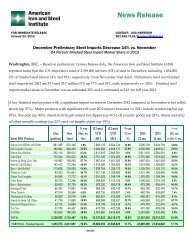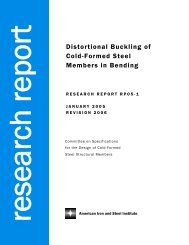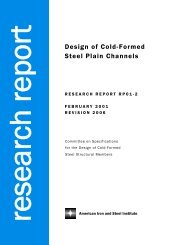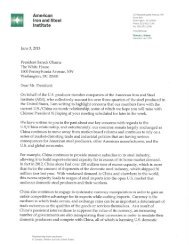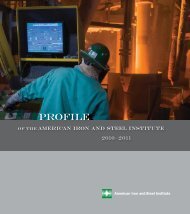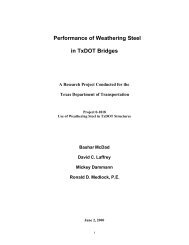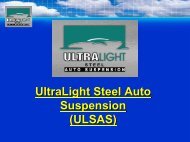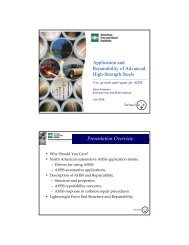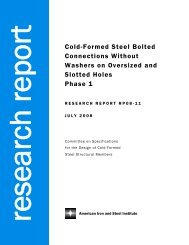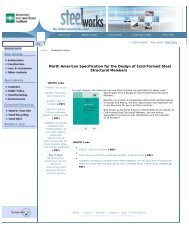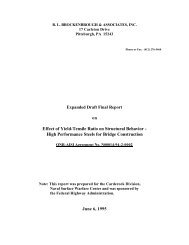Environmental Life Cycle Assessment of Southern Yellow Pine ...
Environmental Life Cycle Assessment of Southern Yellow Pine ...
Environmental Life Cycle Assessment of Southern Yellow Pine ...
Create successful ePaper yourself
Turn your PDF publications into a flip-book with our unique Google optimized e-Paper software.
EXECUTIVE SUMMARY<br />
• Other surveys around China have documented arsenic concentrations as high as 73 mg/L in <br />
water bodies adjacent to arsenic mining and processing operations, which can be linked <br />
directly to wind and storm water run<strong>of</strong>f from waste materials that are inadequately <br />
armored. Arsenic concentrations such as these are thousands <strong>of</strong> times higher than relevant <br />
guidelines established by agencies such as the US EPA. 43 Other studies assessing <br />
concentrations <strong>of</strong> arsenic in rice produced in China found that arsenic concentrations were <br />
greater than four times as high for rice sampled from mining and smelting districts, <br />
indicating another significant exposure pathway for humans. 44<br />
Mine sites such as described here are located in many parts <strong>of</strong> China, and these examples are <br />
considered to be representative <strong>of</strong> current arsenic mining practices in this region. These data all <br />
indicate that arsenic ore production in China, used in the production <strong>of</strong> CCA preservative, is an <br />
impact that could be resulting in the exposure <strong>of</strong> large populations to elevated levels <strong>of</strong> arsenic, <br />
known to be chronically toxic and carcinogenic. Although health effects in the local human <br />
population are extremely likely, these are not well documented due to a lack <strong>of</strong> environmental health <br />
monitoring in the area. Due to the persistent nature <strong>of</strong> arsenic, chronic exposures and health impacts <br />
are expected to be significant, and are almost certainly still affecting substantial numbers <strong>of</strong> people. <br />
1.5.3.2 Herbicide Use During Forestry in the Southeast <br />
Typically, herbicide application is infrequent at the site <strong>of</strong> forest management operations, occurring <br />
only after clear-‐cutting in intervals <strong>of</strong> 10 to 40 years to aid in the reestablishment <strong>of</strong> desired tree <br />
species. However, the chemicals used can lead to toxic effects in humans. The data indicate that both <br />
atrazine and 2,4-‐D are commonly used; 45,46 atrazine is a known endocrine disruptor and considered a <br />
possible carcinogen by the World Health Organization, while 2,4-‐D is considered a possible <br />
carcinogen by the International Agency for Research on Cancer. 47,48 Applications can involve either <br />
aerial or ground spraying, both <strong>of</strong> which are likely to be occurring during forest management in the <br />
Southeastern US. <br />
Due to their tendency to photo-‐degrade in the environment, atrazine, 2,4-‐D, and other herbicides <br />
used in forestry in this region do not present a risk <strong>of</strong> contamination <strong>of</strong> water supplies or food <br />
supplies. However, these chemicals will expose workers in cases where protective equipment is not <br />
adequately utilized. Past research by SCS has indicated that this is a potential route <strong>of</strong> exposure, as <br />
43 United States <strong>Environmental</strong> Protection Agency: Arsenic in Drinking Water. Retrieved on 4/6/2012 from <br />
http://water.epa.gov/lawsregs/rulesregs/sdwa/arsenic/index.cfm <br />
44 Zhu, Y.G., et al. High Percentage Inorganic Arsenic Content <strong>of</strong> Mining Impacted and Nonimpacted Chinese Rice. Environ. <br />
Sci. Technol., 2008, 42 (13), pp 5008-‐5013. <br />
45 University <strong>of</strong> Florida: Institute <strong>of</strong> Food and Agricultural Sciences. Herbicides Registered for <strong>Pine</strong> Management in Florida – <br />
2008. Retrieved on 4/6/2012 from http://edis.ifas.ufl.edu/pdffiles/FR/FR15800.pdf. <br />
46 Georgia Forestry Commission. Herbicides. Retrieved on 4/6/2012 from <br />
http://www.gfc.state.ga.us/ForestManagement/Herbicide.cfm <br />
47 <strong>Environmental</strong> Working Group. Health Effects <strong>of</strong> Atrazine. Retrieved on 5/24/2012 from <br />
http://www.ewg.org/node/25735 <br />
48 International Agency for Research on Cancer. Agents Classified by the IARC Monographs, Volumes 1-‐104. Retrieved on <br />
5/24/2012 from http://monographs.iarc.fr/ENG/Classification/ClassificationsAlphaOrder.pdf <br />
April 2013 | ©SCS Global Services <br />
ES-‐ 19



